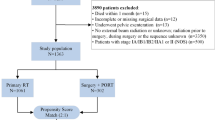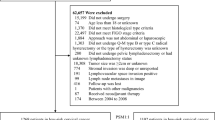Abstract
Purpose
The purpose of this study was to assess the prognostic role and the perioperative outcomes of conization performed before radical hysterectomy in early-stage cervical carcinoma.
Methods
This multicenter, retrospective observational cohort study included patients with FIGO 2009 stage IB1 cervical carcinoma treated with radical hysterectomy between June 2004 and June 2019. Patients were divided into two groups according to conization before radical surgery. One-to-one case–control matching was used to adjust the baseline characteristics.
Results
A total of 332 patients were included after propensity matching (166, 50% in each group). Twenty-four of 166 (14.4%) and 142 of 166 (85.6%) conization patients had negative and positive surgical margins on the conization specimen, respectively. No difference in intra- and postoperative complications was noted between the two groups (p = 0.542 and p = 0.180, respectively). Patients undergoing conization before radical hysterectomy received less adjuvant treatment (p < 0.001) and had a better 5-year disease-free survival (DFS) than patients who did not receive conization (89.8% vs. 80.0%, respectively; p = 0.010). No difference in 5-year overall survival (OS) (97.1% vs. 91.4%, respectively; p = 0.114) or recurrence pattern (p = 0.115) was reported between the two groups. Factors independently related to higher risk of recurrence were pathologic tumor diameter >20 mm and no conization before radical hysterectomy (p = 0.011 and p = 0.018, respectively). The only independent variable influencing OS was pathologic tumor diameter >20 mm (p = 0.020).
Conclusions
Conization before radical hysterectomy was associated with improved DFS and lower probability of receiving adjuvant treatment. No difference in perioperative complications and OS was evident. Tumor diameter >20 mm was found to be the only independent risk factor affecting OS in both groups.



Similar content being viewed by others
REFERENCES
Brisson M, Kim JJ, Canfell K, et al. Impact of HPV vaccination and cervical screening on cervical cancer elimination: a comparative modelling analysis in 78 low-income and lower-middle-income countries. Lancet. 2020;395(10224):575–90.
Wright TC, Stoler MH, Behrens CM, et al. Primary cervical cancer screening with human papillomavirus: end of study results from the ATHENA study using HPV as the first-line screening test. Gynecol Oncol. 2015;136(2):189–97.
Arbyn M, Weiderpass E, Bruni L, et al. Estimates of incidence and mortality of cervical cancer in 2018: a worldwide analysis. Lancet Glob Health. 2020;8(2):e191-203.
Cibula D, Pötter R, Planchamp F, et al. The European Society of Gynaecological Oncology/European Society for Radiotherapy and Oncology/European Society of Pathology Guidelines for the Management of Patients With Cervical Cancer. Int J Gynecol Cancer. 2018;28(4):641–55.
Uppal S, Gehrig PA, Peng K, et al. Recurrence rates in patients with cervical cancer treated with abdominal versus minimally invasive radical hysterectomy: a multi-institutional retrospective review study. J Clin Oncol. 2020;38(10):1030–40.
Casarin J, Bogani G, Papadia A, et al. Preoperative conization and risk of recurrence in patients undergoing laparoscopic radical hysterectomy for early stage cervical cancer: a multicenter study. J Minim Invasive Gynecol. 2020;28:117–23.
Pecorelli S, Zigliani L, Odicino F. Revised FIGO staging for carcinoma of the cervix. Int J Gynaecol Obstet. 2009;105(2):107–8.
Querleu D, Cibula D, Abu-Rustum NR. 2017 Update on the Querleu-Morrow Classification of radical hysterectomy. Ann Surg Oncol. 2017;24(11):3406–12.
Common Terminology Criteria for Adverse Events (CTCAE) v5.0. https://ctep.cancer.gov/protocoldevelopment/electronic_applications/docs/CTCAE_v5_Quick_Reference_5x7.pdf.
Dindo D, Demartines N, Clavien PA. Classification of surgical complications: a new proposal with evaluation in a cohort of 6336 patients and results of a survey. Ann Surg. 2004;240(2):205–13.
Kaplan EL, Meier P. Nonparametric estimation from incomplete observation. J Am Stat Assoc. 1958;53:457–81.
Mantel N. Evaluation of survival data and two new rank order statistics arising in its consideration. Cancer Chemother Rep. 1966;50(3):163–70.
Cox DR. Models and Life-Tables Regression. J R Stat Soc Ser B (Methodological). 1972;34(2):187–220.
Duggan BD, Felix JC, Muderspach LI, et al. Cold-knife conization versus conization by the loop electrosurgical excision procedure: a randomized, prospective study. Am J Obstet Gynecol. 1999;180(2 Pt 1):276–82.
Jiang YM, Chen CX, Li L. Meta-analysis of cold-knife conization versus loop electrosurgical excision procedure for cervical intraepithelial neoplasia. Oncol Targets Ther. 2016;9:3907–15.
Derks M, van der Velden J, de Kroon CD, et al. Surgical treatment of early-stage cervical cancer: a multi-institution experience in 2124 cases in The Netherlands over a 30-year period. Int J Gynecol Cancer. 2018;28(4):757–63.
Matsuo K, Mandelbaum RS, Machida H, et al. Association of tumor differentiation grade and survival of women with squamous cell carcinoma of the uterine cervix. J Gynecol Oncol. 2018;29(6):e91.
Allam M, Feely C, Millan D, Nevin J, Davis J, Siddiqui N. Depth of cervical stromal invasion as a prognostic factor after radical surgery for early stage cervical cancer. Gynecol Oncol. 2004;93(3):637–41.
Ramirez PT, Frumovitz M, Pareja R, et al. Minimally invasive versus abdominal radical hysterectomy for cervical cancer. N Engl J Med. 2018;379(20):1895–904.
Pedone Anchora L, Turco LC, Bizzarri N, et al. How to select early-stage cervical cancer patients still suitable for laparoscopic radical hysterectomy: a propensity-matched study. Ann Surg Oncol. 2020;27(6):1947–55.
Chiva L, Zanagnolo V, Querleu D, et al. SUCCOR study: an international European cohort observational study comparing minimally invasive surgery versus open abdominal radical hysterectomy in patients with stage IB1 cervical cancer. Int J Gynecol Cancer. 2020;30(9):1269–77.
Kong TW, Chang SJ, Piao X, et al. Patterns of recurrence and survival after abdominal versus laparoscopic/robotic radical hysterectomy in patients with early cervical cancer. J Obstet Gynaecol Res. 2016;42(1):77–86.
Kanao H, Matsuo K, Aoki Y, et al. Feasibility and outcome of total laparoscopic radical hysterectomy with no-look no-touch technique for FIGO IB1 cervical cancer. J Gynecol Oncol. 2019;30(3):e71.
Kohler C, Hertel H, Herrmann J, et al. Laparoscopic radical hysterectomy with transvaginal closure of vaginal cuff: a multicenter analysis. Int J Gynecol Cancer. 2019;29(5):845–50.
Pedone Anchora L, Bizzarri N, Kucukmetin A, et al. Investigating the possible impact of peritoneal tumor exposure amongst women with early stage cervical cancer treated with minimally invasive approach [published online ahead of print, 2020 Oct 3]. Eur J Surg Oncol. 2020;S0748-7983(20)30829-5.
Orr JW Jr, Shingleton HM, Hatch KD, Mann WJ Jr, Austin JM Jr, Soong SJ. Correlation of perioperative morbidity and conization to radical hysterectomy interval. Obstet Gynecol. 1982;59(6):726–31.
Acknowledgment
The authors thank the surgical team and the scrub nurses at Policlinico Gemelli IRCCS, Rome, Italy and at Northern Gynaecological Oncology Centre, Gateshead, UK.
Author information
Authors and Affiliations
Contributions
Conceptualization: NB, LPA, GS; Data curation: NB, LPA, PK, VC, MVC, MB; Formal analysis: NB, LPA; Methodology: AKM, NR, VC, GV, VC, AF, FF, GF; Project administration: NB, GS; Supervision: GS; Validation: GF, FF, AKM, NR, RPDV; Writing - original draft: NB, GS; Writing - review & editing: AKM, NR, GF, FF, LPA.
Corresponding author
Ethics declarations
Disclosures
Anna Fagotti's disclosures of interest: Grant/Research Support: MSD Italia S.r.l.; Consultant for: Glaxo Smith Kline p.l.c.; Speakers Bureau/Honoraria: PharmaMar S.A.; Consultant for: Johnson & Johnson SpA; The other authors declare no conflict of interest.
Additional information
Publisher's Note
Springer Nature remains neutral with regard to jurisdictional claims in published maps and institutional affiliations.
Supplementary Information
Below is the link to the electronic supplementary material.
Rights and permissions
About this article
Cite this article
Bizzarri, N., Pedone Anchora, L., Kucukmetin, A. et al. Protective Role of Conization Before Radical Hysterectomy in Early-Stage Cervical Cancer: A Propensity-Score Matching Study. Ann Surg Oncol 28, 3585–3594 (2021). https://doi.org/10.1245/s10434-021-09695-4
Received:
Accepted:
Published:
Issue Date:
DOI: https://doi.org/10.1245/s10434-021-09695-4




